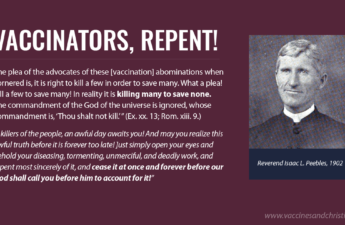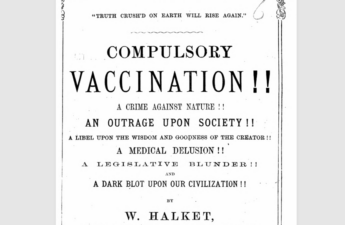
by Steve Halbrook
As we have seen constantly shifting narratives regarding COVID and the COVID shot, let us explore history, and see that from the outset, vaccine narratives were shifting. This is of course what we would expect, given that vaccination is an unscientific delusion that not only fails to protect one’s health, but destroys it.
Vaccination, in short, does not live up to its promises, and so requires constantly changing goalposts.
Initially, there was smallpox variolation/inoculation — vaccination in all but name. Here, smallpox sores (pustules) from an infected person were inoculated into the bloodstream of someone else. This was initially hyped up as protective against smallpox, but then it was discredited as being a deadly spreader of smallpox — and then criminalized:
From Robert A. Gunn, Vaccination: Its Fallacies and Evils, around 1877:
As early as 1713, an English physician who had settled in Constantinople, wrote to a practitioner in London, concerning a new process, which was claimed to be successfully employed as a preventive against the ravages of small-pox. This process consisted in taking the virus of the small-pox and introducing it into a slight puncture in the skin, thus producing the disease in a modified form. This practice was called inoculation … Its advocates claimed that the ravages of the small-pox were thus greatly diminished, and the profession and public were as zealous in extending it, and advocating its efficacy, as they are to-day in urging vaccination.
After this latter practice had been introduced, however, it was asserted that inoculation added greatly to the number of small-pox cases, and that the mortality was not diminished, but rather increased. Laws were then passed in the different countries making inoculation a crime.
Robert A. Gunn, Vaccination: Its Fallacies and Evils (NY: Munroe & Metz, 1877?), 4, 5
But one poison was replaced by another. Smallpox vaccination was popularized in England by Edward Jenner around 1798. Instead of using diseased smallpox matter from another person (as in smallpox variolation), smallpox vaccination used diseased cowpox matter from the cow (which was claimed to be protective against smallpox!).
It was still a form of inoculation, but the word “vaccination” was used due to the use of cowpox (“vaccine” is from Latin “vaccinus,” from vacca “cow”).
But again, the process was quackery — and so we find more shifting narratives and goalposts to cover up its false efficacy and deadliness. (Not all proponents are deliberately deceptive — some have been tricked by a delusion.) Vaccination became more and more “temporary” — and there was even a period where it was applied arm to arm, contrary to sanitation 101!
Again, from Robert A. Gunn, Vaccination: Its Fallacies and Evils:
For a time Jenner’s discovery [of smallpox vaccination, ed.] was bitterly opposed by the profession : and even some of those who adopted it, claimed that inoculation directly from the grease of the horse, into the human body was as protective as that which passed through the cow. Then came the claim that the virus taken from the person inoculated with the cow-pox, could be used to protect other persons ; and, as the symptoms thus produced were less severe than direct inoculation from the cow, this method of vaccination soon became the prevailing one. At first, however, it was considered necessary to have recourse to the cow for a fresh supply of virus, every few years ; but even this was soon regarded as unnecessary, and so the practice of vaccination from arm to arm has been almost universally relied upon as a preventive of small-pox, for half a century. …
At first, all agreed with Jenner, that one vaccination protected a person for life, against small-pox ; this, however, was soon found to be untrue. Then, one thorough vaccination in infancy and one after puberty, were deemed necessary. This also proved a delusion. Its advocates next advised the practice to be repeated at maturity, and finally it was thought necessary to assure perfect immunity, that vaccination should be repeated every three or four years.
This is the position occupied by most of the profession at the present day, although even here there is a marked difference of opinion among the so-called best authorities.
In the London Lancet of March 24th, ’77, the editor writes as follows : “After successful vaccination in infancy, re-vaccination is needed only once. The second operation should, if practicable, be performed at the age of puberty, or, there being immediate danger of small-pox, at the age of twelve. Re-vaccination at an earlier age is futile. Repeated re-vaccinations are foolish. Re-vaccination, when successful, is needed once only.”
Vaccination as performed in different countries varies very materially, and all the methods are in conflict with the theories of Jenner. …
But we are told, that vaccination has arrested the fearful ravages of small-pox, and reduced its mortality to almost nothing. We have been told over and over again that small-pox had been stamped out in different localities, by efficient vaccination ; and after it had again appeared the cry came, “the people are not half vaccinated.”
Robert A. Gunn, Vaccination: Its Fallacies and Evils (NY: Munroe & Metz, 1877?), 7, 9.
In Vaccination Fallacies (1879), Henry Pitman also covers shifting narratives — not just regarding re-vaccination, but that narrative that the vaccinated who get smallpox anyway will have it in “milder” form — even when fatal! (So much for protection. This is the same playbook we have seen regarding the COVID vaccine.)
Pittman also covers the tactic of basing vaccine protection on “visible marks” (scars at the vaccination site), which enable the vaccinators to claim that many who got smallpox were unvaccinated, when in fact they were (as smallpox rashes can cover such marks).
When it was evident that vaccination did not perfectly “protect” from small-pox, the next fallacy propounded was that the sufferers had the disease in a “milder” or “modified” form; therefore, when it even proved fatal, there was the satisfaction that the vaccinated patients died of small-pox in a modified form. …
Another vaccination fallacy is, that its supposed “protection” is in proportion to the number of “marks.” Who counts the marks on the patients? Interested persons; and consequently when the marks are obliterated by the disease, the partisans of the poisoning theory give their fallacy the benefit of the doubt, and generally register the patients as “unvaccinated.”
The failure of vaccination as a protection, led to the newer fallacy of “re-vaccination.” The “protection for life” theory having worn out, the process of vaccination must be renewed every few years, the oftener the better-for the doctor’s pocket. It was confidently asserted for some time that no re-vaccinated person ever had small-pox. This fallacy has been disproved with fatal frequency.
Henry Pitman, Vaccination Fallacies, The Vaccination Inquirer and Health Review, No. 9, December 1879, in The Vaccination Inquirer and Health Review, Volume the First, April 1879 to March 1880 (London: Edward W. Allen, 1880), 127, 128.
On the matter of re-vaccination, even this pro-vaxxer writing to the Monthly Homoeopathic Review understood the absurdity of the procedure:
Gentlemen, – In a leading article in the Lancet of Saturday, Jan. 14th, based on Mr. Simon’s “Instructions” for the prevention of small-pox, the following sentence occurs :-“It is evident that re-vaccination is almost as necessary as vaccination, if the public is to be saved from such epidemics as the present.” What does this mean? At first sight it would seem to imply that the whole population of these isles-to speak only of our own country-should be re-vaccinated! The writer would scarcely venture to recommend so extreme a measure. But if not the whole, then what proportion? Who are the proper subjects for re-vaccination? How often, and how many times, should it be repeated? At what period of life does it cease to be necessary? What evidence have we on these points? By what data are we to be guided? To such questions as these, no satisfactory answer has yet been given.
Monthly Homoeopathic Review, February 1, 1871, in The Monthly Homoeopathic Review, Vol. XV, eds. J. Ryan and A.C. Pope (London: Henry Turner and Co., 1871), 26, 127.
A clever way to hide vaccine failures was to claim that some vaccinations were accidentally “spurious” or “imperfect.” In 1842, Drs. Richard T. Evanson and Henry Maunsell — though pro-vaccine — nevertheless write:
The term imperfect or spurious vaccination is frequently to be met with in books, and has been the cause of no small degree of confusion in practice, although, at the same time, it has frequently afforded the practitioner an excellent asylum against the storms now and then arising out of failures in the protective powers of the vaccine disease.
Richard T. Evanson and Henry Maunsell, A Practical Treatise on the Management and Diseases of Children (Dublin: Fannin & Company, 1842), 489, 490.
Other terms to hide behind might have been “unsuccessful” or “partial” vaccination.
Reverend William Hume-Rothery sums up the changing goalposts of vaccination (namely, re-vaccination) as admission of the failure of vaccines:
Many re-vaccinations have been performed in Harwich, and some papers have been exalting re-vaccination as a protection against small-pox. A calm and sound mind must judge differently. Re-vaccination is a confession of the failure of vaccination.
William Hume-Rothery, January 28, 1878, in National Anti-compulsory-vaccination Reporter, Vol. II, No. 6, March 1, 1878, in National Anti-compulsory-vaccination Reporter, Vol. II, October 1877 to September, 1878, 104.
Fool me once, shame on you. Fool me twice, shame on me.
If you find this site helpful, please consider supporting our work.


